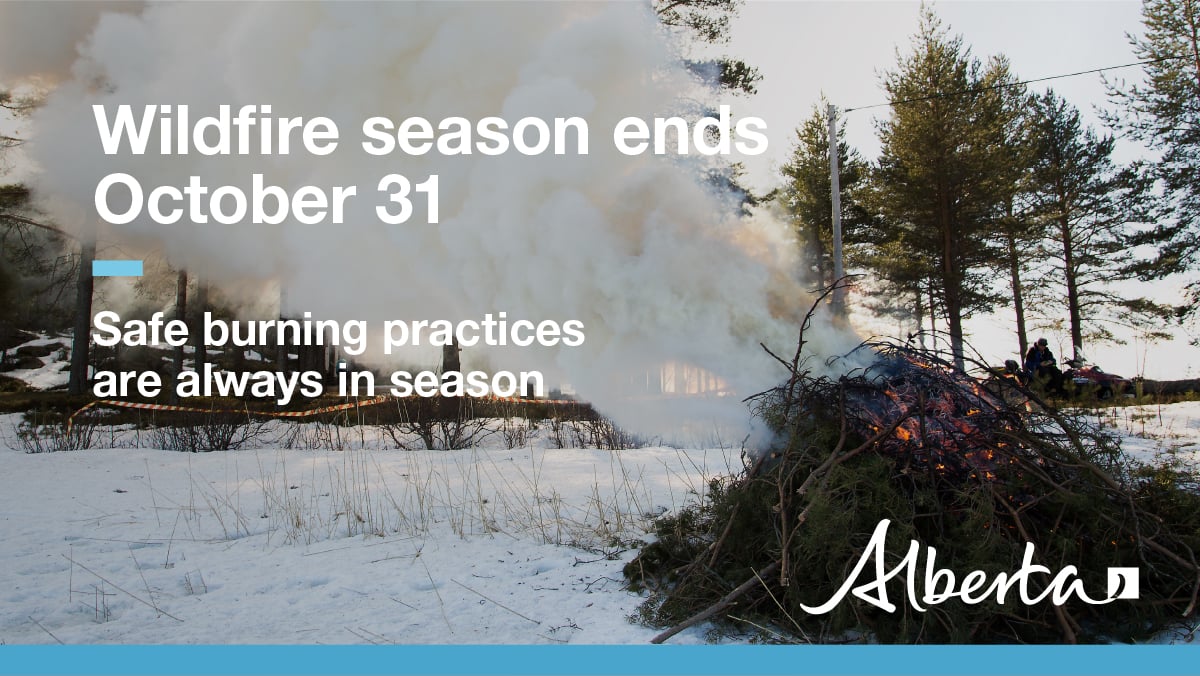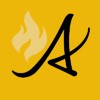
End of Wildfire Season
Although the wildfire season in Alberta has officially ended, firefighters urge everyone to continue to be cautious as without snow, areas of dead grass are dry and any spark, friction or hot exhaust can easily start a wildfire.
Firefighters do respond to wildfires, even in the winter. If you spot a wildfire report it by calling 310-FIRE.

Wildfire Summary
This season, there were 165 wildfires in the Slave Lake Forest Area of which 92 were human-caused, representing 55 percent. At the provincial level, 805 of the 1,307 wildfires that burned in the Forest Protection Area of Alberta – or 62 percent – were human-caused.
On average, the total number of human-caused wildfires in Alberta has been declining in the past five years. Firefighters commend your efforts and ask that you continue to follow all precautions to reduce these preventable wildfires.
Winter Burning
From November 1st to February 28th fire permits are not required for burning in the Forest Protection Area of Alberta. Even though a fire permit is not required, you are still responsible for any fires you ignite outside of the wildfire season. Take the time to properly prepare your burn site. Know the requirements needed to be successful during your burn and how to properly extinguish your site.
Prior to and while burning:
Winter burns should be conducted in areas with sufficient snow cover of more than 15 centimetres and burns must be monitored the entire time. Brush piles and windrows should be free of soil, built no higher than three metres and have a fireguard or cleared land around it to prevent the fire from spreading. Only burn what you can control with the equipment and people you have available, and adjust your burning according to weather conditions.
Smoke safety:
Avoid creating smoky conditions by conducting winter burns on days with averages temperatures and wind speeds over five kilometres per hour. On days with lighter wind speeds and lower temperatures, inversions can occur causing smoke to stay close to the ground and travel great distances which causes dangerous driving conditions and can impact nearby communities.
Ensure smoke warning signs are in place before burning within half a mile (800 m) from a roadway. For more information on smoke management and to acquire signs, contact your local municipality. If you are outside of a municipality, contact Alberta Transportation. Read over the Recommended Practices for placement and instruction of a “Smoke Ahead” sign.
After burning:
Fires ignited in the winter which are not properly extinguished, can burn underground all winter long and can re-emerge as wildfires in the spring. After your burn be sure to revisit your sites.
When putting out your winter burn:
- Spread remaining material within the pile and soak with water as required.
- Check the area and ensure both heat and smoke are no longer being produced by the pile – it should be cool to the touch.
- Check your burn site multiple times in the following weeks to ensure it has not reignited.
For more information on brush pile and windrow safe burning practices click here. If you have questions about your winter burning project please call Slave Lake Forest Area Wildfire Technologist Russell Murphy at 780-849-7457.
Do your part to prevent wildfires
Campfires
When you’re finished with your campfire, make sure you properly extinguish it.
When putting out your campfire:
- Spread the embers within the fire pit, then add water or loose dirt and stir.
- Expose any materials still burning, then add more water and stir again until you can no longer see smoke or steam.
- Repeat until your campfire is cool to the touch. You should not be able to feel any heat from the ashes.
.png?width=1201&name=WF_Social-images%20(4).png)
Off-Highway Vehicles
Exhaust systems on off-highway vehicles heat up to temperatures in excess of 204 degrees Celsius; hot enough to fry an egg and start a wildfire. At these temperatures, built up materials and debris on your machine (such as grass, muskeg, moss, or other debris) can heat up, smoulder and ignite. The smouldering debris can drop to the ground as you’re riding, starting a wildfire.
When using an off-highway vehicles follow these simple steps to reduce the risk of your vehicle causing a wildfire:
- Before you ride, clean out hot spots and remove debris from your machine.
- After riding through muskeg or tall grass, stop and remove any build-up from your machine.
- Carry firefighting equipment such as a small shovel, collapsible pail or fire extinguisher.
- Wash your quad, trike or bike and keep it clean; do not wash in streams and creeks.
- Make sure your muffler and spark arrestor are working properly.
- Stop frequently. Take the time to knock debris from your machine’s hot spots. If the debris is smouldering, soak it, stir it, and soak it again to make sure it’s out.
.png?width=660&name=WF_Social-images%20(2).png)
Wildfire Information
Download the new app today and get access to accurate, real-time information on wildfires in your area. You can also find information on fire advisories, restrictions and bans across the province and much more.
Available for Apple and Android.
Before heading out, please check albertafirebans.ca to determine whether there are any fire advisories, fire restrictions or fire bans in effect for your destination.
Subscribe to the Slave Lake Forest Area Wildfire Update to receive an email when new information is posted.
Join the conversation on Facebook, Twitter or Instagram.
Updates are provided weekly when the wildfire danger is low to moderate and daily when the wildfire danger reaches high to extreme.
Unless conditions change you can expect your next wildfire update on December 1st, 2021.
If you have any questions please contact:
Leah Lovequist
Wildfire Information Officer
Mobile:780-849-0945
Email: leah.lovequist@gov.ab.ca
RELATED INFORMATION
Websites:
